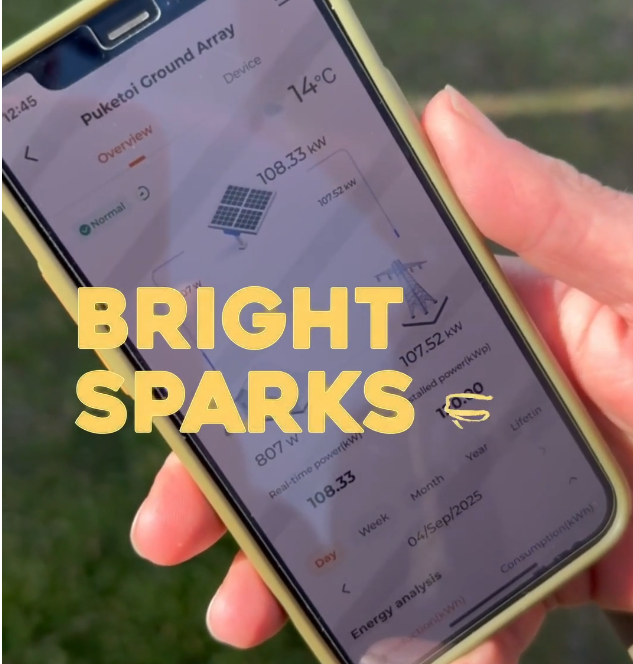Up the Kilowahs! Checkout the EDB Scoreboard



The Crutchley family has been turning sunlight into food and fibre on their Maniototo farm since 1939. Now, Emma Crutchley and Kyle Hagen are turning sunlight into energy.
Their solar setup helps to irrigate over 200 hectares on their sheep and beef farm and also runs the farm sheds, workshop and farmhouse. Any excess is stored in batteries or sent back out to the grid.
While there are significant upfront costs attached, Becks Smith, co-founder of Solayer, which installed the system, says farmers can expect to pay it back in around five years primarily through the savings on electricity bills.
Smith says farmers often have to compromise to reduce their costs (for example, a reduction in fertiliser use may affect production), but solar is a way for farmers to reduce costs without having to compromise on anything and, as Rewiring Aotearoa’s research showed, it is popular across all farm types and age groups, with 70% of respondents to a survey last year saying they were interested.
Solar can also be a gateway drug to electrification. Anecdotally, homeowners with solar tend to be more interested in electric vehicles when they realise they have an energy source on their roof that they should be making the most of, and farmers with solar are more likely to look at the machines they’re using - from tractors to mowers to frost fighting fans - and try to figure out how to electrify them because it makes economic sense over the long-run.
Batteries on farms (and in homes) are less of an economic slam dunk than solar at the moment, but Smith says they are still seeing impressive payback periods and those are likely to improve as prices continue to drop and higher rates for peak exports become more common.
As New Zealand’s economy electrifies, we will need more renewable generation and farms could play a much bigger role in the energy system. If 50,000 farms installed a mid-sized solar system, that could generate 60% more electricity - and more big battery set ups can help power other homes in the area without the need for expensive infrastructure upgrades.
Just as Forest Lodge Orchard has provided a powerful demonstration project, Crutchley and Smith are showing how well it stacks up for other types of farms and inspiring others to follow suit.

It's time to show some interest in low-interest, long-term energy loans; looking enviously across the seas at Australia's energy push; an electric atmosphere beckons as the Special Olympics heads to the all-electric Parakiore indoors sports and swimming centre in Christchurch; EV Maritime's Michael Eaglen and Evnex's Ed Harvey share their views; Volkswagen follows the honey in its electric van; and climate comedian Oli Frost generously creates an ad campaign for French bank Société Générale.
Read moreDownload
You may have heard there's an 'electric election' coming up next year. We've met with a huge range of politicians from right across the spectrum and the ones who pick up what Rewiring is putting down are often those who have already invested in solar, batteries, EVs, heatpumps and induction cooktops and have experienced the benefits first hand. That's why we're kicking off a new series called Political Power, where we talk to some of our decision makers about the decisions they've made in their own lives and how they plan to reduce energy bills for others, reduce emissions and improve our resilience and energy security.
Read moreDownload
Electrify everything. Electrify everyone. Electrify New Zealand. That's Rewiring Aotearoa's vision and our CEO Mike Casey gave a condensed version of what we've done and what we're doing at our Electric Christmas party recently. As he said to a large crowd at Ecotricity, which kindly hosted the event and provided the excellent electric cake, 2024 was the year of the thinking, 2025 was the year of the doing, and 2026 will be the year of mass adoption.
Read moreDownload